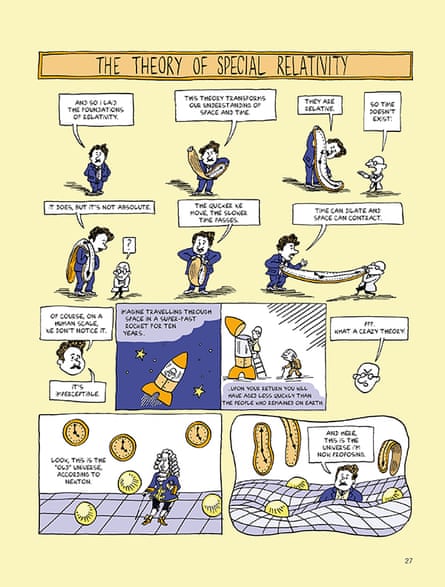What do Albert Einstein, John James Audubon and Zora Neale Hurston have in common? Not much, apart from all being part of a new boom of graphic biographies.
Using comics to tell life stories is an established art: think Maus, Art Spiegelman’s investigation of his family’s ordeal during the Holocaust; or Marjane Satrapi’s Persepolis, her memoir of an Iranian childhood. More recently, the March trilogy by US congressman and civil rights hero John Lewis, with Andrew Aydin and Nate Powell, was sent shooting up bestseller charts after a spat between Lewis and US president Donald Trump.
But while superheroes, science fiction and horror still comprise the majority of the comic book market, a flood of deeply researched graphic biographies have recently been published. Some subjects – Vincent Van Gogh, Albert Einstein, Gandhi, Sigmund Freud – are well-known; others less so, such as novelist and folklorist Zora Neale Hurston in Fire!!, or 19th-century ornithologist John James Audubon, in the sumptuously illustrated On The Wings of the World.

“Comic-book memoirs have perhaps been more successful than biography in the past – I’m thinking people such as Spiegelman, Robert Crumb, Satrapi,” says Peter Bagge, whose Hurston biography, Fire!!, was published in March by Drawn + Quarterly. “It’s already the creator’s own story, and that gives you a lot more freedom. With a biography there are a lot of people going to be questioning you and what you create about a person.”
Bagge starts by reading traditional biographies of his subjects, then boils down their lives into a series of key moments. In his biography of Hurston, Bagge pinpointed moments such as when the magazine Opportunity – “The Journal of Negro Life” – accepted her first short story in 1924, and or when she moved to Harlem on the advice of the editor. Bagge writes all of this into a script he later uses uses to draw from. Without pages and pages of exposition, comics can boil a life down to the bare essentials by marrying art and text – Hurston’s being accepted for publication and moving to New York is told in a single page.
Bagge’s first full-length graphic biography was Woman Rebel, about activist and birth control campaigner Margaret Sanger. “I don’t set out to cover the entire lives of the people I write about,” he says. “With both Sanger and Hurston, their lives were very busy and interesting right up to the end, so it’s a case of making that work in comic form.”
The whole process takes around three years per book – but it’s a long haul that Bagge enjoys. He is currently at work on a biography of Rose Wilder Lane, the writer and journalist daughter of Little House on the Prairie author Laura Ingalls Wilder. “Reality beats the made-up stuff,” he says.
The compact form does not mean there is any less research, say Anne Simon and Corinne Maier, who created bestselling biographies of Karl Marx, Albert Einstein and Sigmund Freud. Like Bagge, artist Simon researches to “find ‘my’ Freud, ‘my’ Marx, ‘my’ Einstein”, while writer Maier reads extensively about her subject before starting. While she knew the life and work of Freud, and understood Marxism, she says she knew nothing about Einstein. “I was very surprised to learn that he was a womaniser!” she says. “I could not imagine him in bed with a woman … but seriously, I immersed myself in relativity, I sweated blood and water to try to understand it.”

The popularity of comic-book biographies has seen subjects who might not get attention from a prose publisher immortalised on the page. These include Somali runner and refugee Samia Yusuf Omar, featured in An Olympic Dream by Reinhard Kleist; or The Boxer, from the same author, about Holocaust survivor Harry Haft; and adventurous journalist William Seabrook, in Joe Ollmann’s The Abominable Mr Seabrook.
This shift may strike the cynically minded as a turn for the horribly stupid, like the apocryphal tales of students using Classic Illustrated comic books like Moby-Dick to do their English literature homework, instead of, say, the actual Moby-Dick. But aren’t comic-book biographies, due to their layout, unavoidably less detailed than their traditional counterparts?
Not at all, says Sam Humphrey, of British comics publisher SelfMadeHero, who praises comic-book biographies as being part of a sophisticated shift away from superheroes: “[They] are often concise, accessible, even breezy, but they rarely lack the weight of research. The kind of scene-setting that might require 20 pages of prose can be accomplished in a couple pages of artwork; a single splash page can conjure the sights, sounds and smells of a particular place at a particular time,” he says. “And they can be read in a day or two – that’s an obvious benefit.”

Comments (…)
Sign in or create your Guardian account to join the discussion